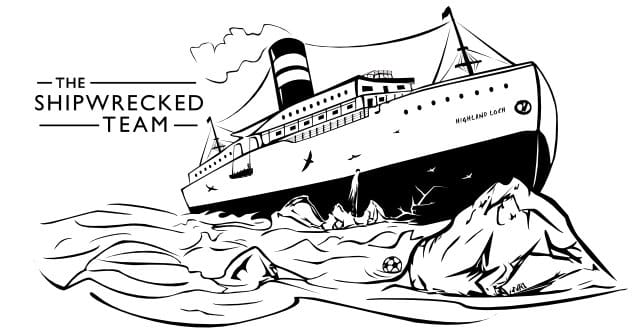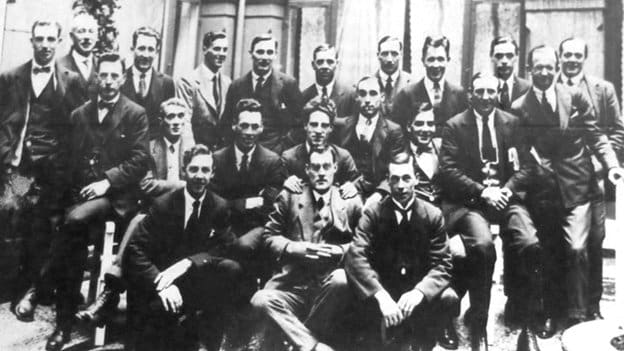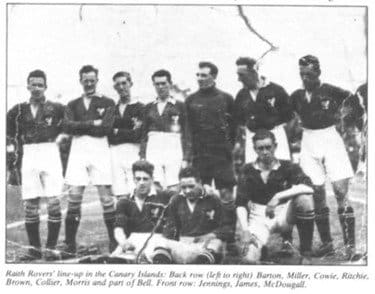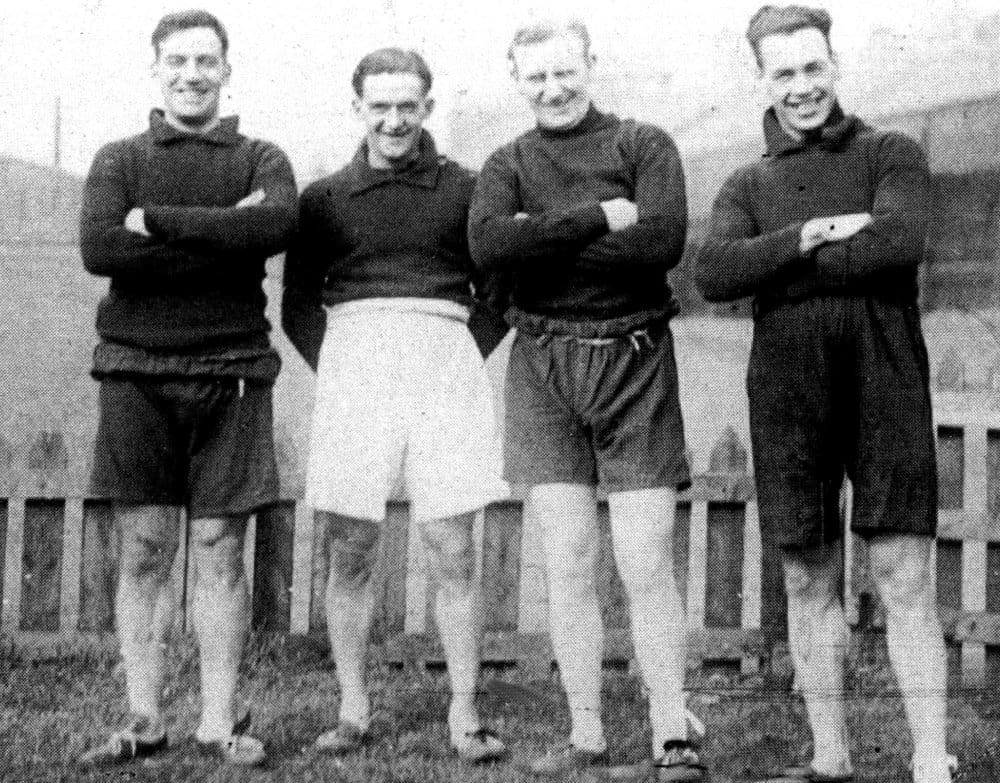Club 24/07/2023
Raith Rovers – The Team That Was Shipwrecked
 In 1922, Raith Rovers embarked on their first major overseas venture, with an ambitious trip to Denmark.
In 1922, Raith Rovers embarked on their first major overseas venture, with an ambitious trip to Denmark.
The journey began on May 10th, as the travelling party headed to London and then proceeded to Harwich for the ferry to Esbjerg, Denmark.
Upon arrival, Raith Rovers faced a Danish XI, consisting mostly of the Danish national team, and unfortunately lost 3-1 in front of a 20,000-strong crowd.
However, they quickly bounced back and defeated a Copenhagen Select team 2-0, with goals from Tom Jennings and Bill Collier.
The successful trip inspired the club to continue exploring foreign trips for friendly matches.
There was also a hope that these voyages could be profitable, which may have been a motivating factor.
The club was facing financial challenges, as they had announced a yearly loss of £632 in June, adding to their existing arrears, resulting in a deficit of £943. The reasons for these financial difficulties were attributed to increasing players’ wages and declining attendance at Stark’s Park due to the ongoing trade depression.
In late June 1923, during the reign of George V and Prime Minister Stanley Baldwin, Raith Rovers arrived at Tilbury Docks to embark on their next journey.
The travelling party included thirteen players, five directors, and their manager, James H Logan. They boarded the SS Highland Loch, a 7,493-ton steamer belonging to the Nelson Steam Navigation Company.

The steamer was initially bound for Spain, where The Rovers would disembark, and then proceed to Argentina. The ship’s other cargo was a consignment of chilled beef.
As part of the plan, The Rovers’ party was to spend a night in Vigo, Spain, where they would watch a bullfight while the Highland Loch was replenished.
Afterwards, they would reboard the steamer to continue their journey to the Canary Islands, where six games had been arranged.
As the journey began along The Thames, the players enjoyed their time by playing cards, engaging in deck games, and looking forward to witnessing their first-ever bullfight in Vigo.
The adventure at sea felt like a holiday, and after a week into the journey, the team’s spirits were high and optimistic.
“Practical jape-mongers all of them,” Alex James recalled in his autobiography.
Early on Sunday July 1st, James ran himself a bath while some members of the squad remained asleep in their bunk beds.
As the Highland Loch sailed towards Cape Finisterre, some of the squad members lounged around on deck in their pyjamas, attempting to catch a glimpse of Spain’s Galicia through the fog. It was at this rocky cape that the Romans had once believed to be the edge of the world.
At 8:29 am, the boat chugged along as usual, with the hisses and gurgles becoming familiar background noise to everyone on board. However, just a minute later, there was a sudden and powerful bang, and all noise ceased as the boat came to a standstill.
Rovers’ captain, Bill Inglis, expressed his astonishment in one of his regular postcard diaries in the Courier, describing it as “What a commotion, what an experience!” Tom Jennings referred to it as “A tremendous smash!”
The seriousness of the situation became evident as alarm bells rang, prompting the crew to instruct passengers to put on their lifejackets.
Inglis recalled how he and his teammates struggled to put on the lifejackets, as none of them had ever worn such gear before. The exception was goalkeeper James Brown, who had served as a “gallant” able seaman during World War One.
In a light-hearted moment, at least two players, Jennings and Alec Cowie, managed to grab their money and purses, with Jennings humorously remarking, “Being good Scotsmen…”!
Initially, James thought the commotion might be a practical joke and continued with his bath.
However, as the situation escalated, he slowly realised that something serious was happening: “Whistles were blowing on deck, and people were running about and shouting”. Water started to seep into the corridors and cabins.
The squad gathered on deck and assisted other travellers in boarding the ship’s rescue boats, prioritizing women and children first.
Amidst the chaos, there was no panic among the Stark’s Park players.
In fact, they demonstrated remarkable composure and bravery, ensuring that women and children were safely guided into the lifeboats before they themselves evacuated the ship.
Despite most of them still being in their pyjamas, the players and directors climbed down ropes to join the lifeboats.
Club captain Bill Inglis sent a telegram back home, praising the gallantry displayed by the players during the rescue operation. He described the incident as a tremendous commotion and an unforgettable experience.
As the command to don lifebelts was issued, it became apparent that many of the passengers were still in bed, caught unaware by the urgency of the situation.
Several individuals encountered difficulties while trying to adjust and put on the lifebelts, adding to the challenges during the rescue operation.
Some passengers were towed to the port of Corrubedo, while others ended up in the village of Vilagarcia de Arousa.
Despite the severity of the collision, miraculously, there were no significant injuries reported.
Investigating divers later discovered the extent of the damage to the Highland Loch, with its bow badly ruptured, a bulkhead wall torn by 18 yards, and its port-side bilge keels ripped clean away.
The following evening brought good news as it was announced that the Highland Loch had been patched up enough for the travelling party to reboard and be towed to Vigo.
Once in Vigo, the shipwrecked players resumed their voyage to the Canary Islands, this time aboard the Darrow, a South American line ship, with a stopover en route in Lisbon.
Upon resuming their voyage, the players were honoured with an invitation to dine at the Captain’s Table as a token of appreciation for their bravery during the collision with the rocks.
Upon their arrival in Las Palmas, the party stayed at the Metropole Hotel. A week after the Highland Loch ran aground, the Raith Rovers’ team faced Real Vigo in their first game on the island.

Raith Rovers players before one of the friendlies.
The match took place in a sandy bull ring, with a crowd of 8,000 spectators watching through a 12-foot-high fence of barbed wire. Rovers secured a 1-0 victory, with Tom Jennings scoring the decisive goal.
In the following game against the same opponents, Rovers triumphed 3-1. Jennings scored from the penalty spot in just five minutes, followed by Alex James adding a second goal after 30 minutes, before Vigo pulled one back from a penalty they were awarded. Alex Ritchie sealed the win with the third goal for The Rovers.
The team continued their success with a 4-0 victory over local side Victoria Porteno, featuring goals from Cornelius Hilley (2), James, and David Morris. They then defeated Gran Canaria 5-1, with Tom Jennings impressively scoring all five Rovers goals.
However, this game was not without controversy as Cornelius Hilley, known as Con, was sent off for a tackle and refused to leave the pitch. The referee had to call in two police officers with drawn swords to escort Hilley off the field.
Raith took the matter up with the British consul and the club received an apology. Victoria were also defeated 2-0, with Tom Jennings scoring both goals.
In the final game, Raith Rovers beat Marino 2-1, with the goals coming from Cowie and Hilley. Remarkably, the team secured six wins out of six games during the tour, with Tom Jennings scoring an impressive 11 goals.
This was a remarkable Raith Rovers side.

Bill Inglis was sold to Sheffield Wednesday before moving on to play for Manchester United.
David Morris captained Scotland while playing for Raith Rovers before being sold to Preston North End. Bill Collier was also capped by Scotland and played for Sheffield Wednesday.
Alex James was sold to Preston North End before joining Arsenal, where he won the English First Division Championship four times and the FA Cup twice. He was also part of the famous “Wembley Wizards” Scotland team that defeated England 5-1 at Wembley, scoring twice.
Tom Jennings was sold to Leeds United, where he scored an impressive 117 goals in 174 games, making him the third-highest scorer in Leeds history, a record that still stands to this day.
Written by John Greer
